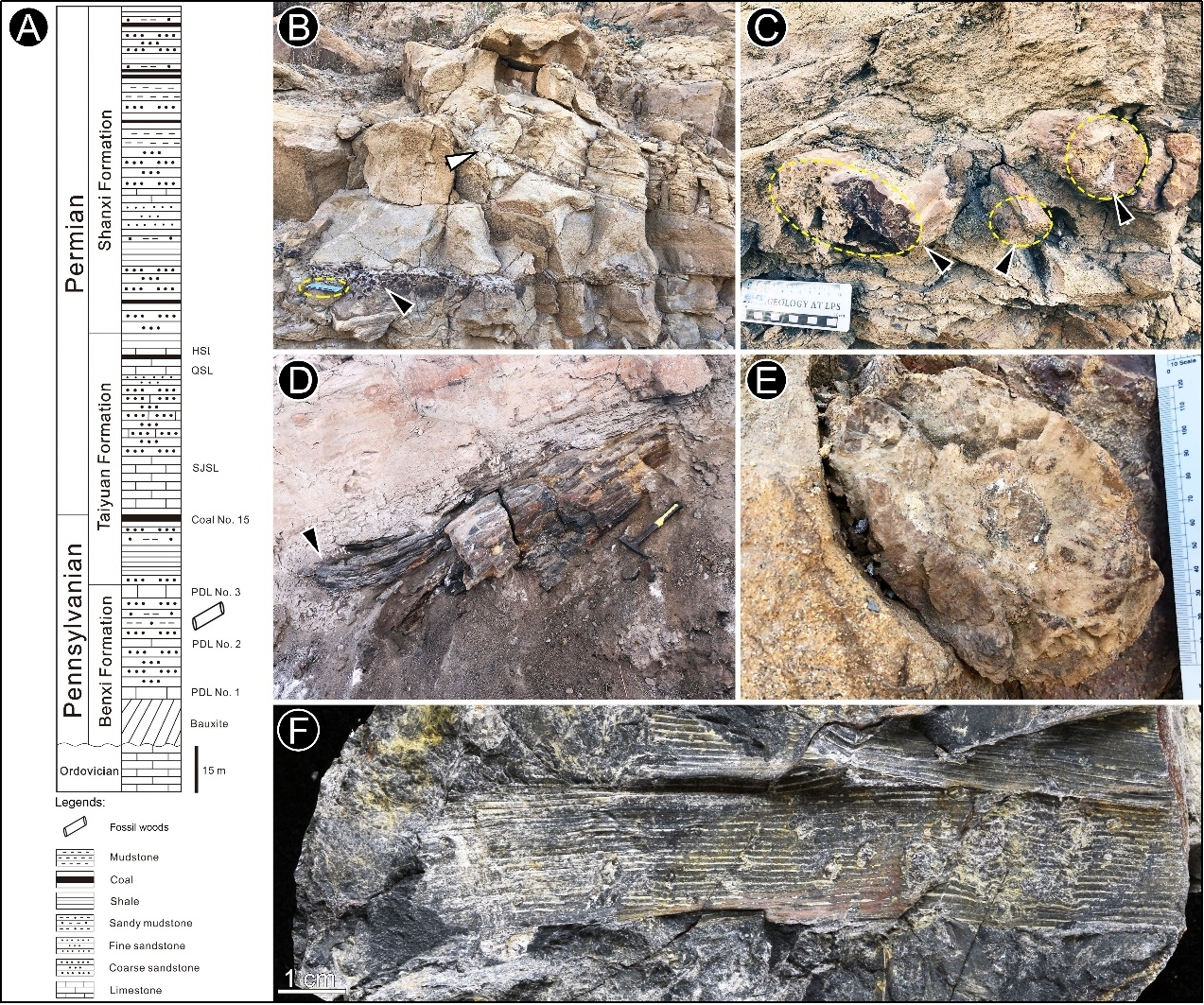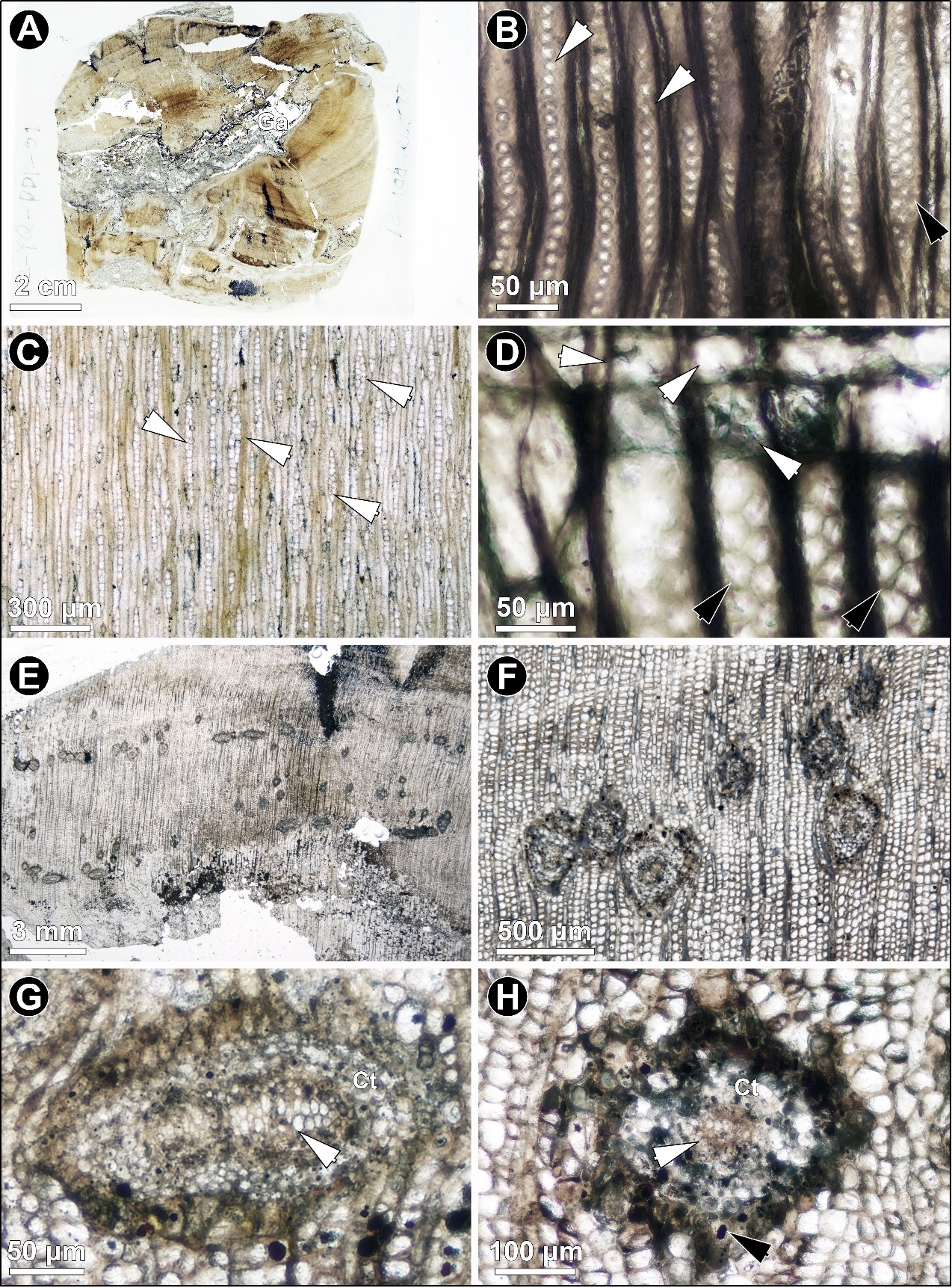The systematic taxonomy of Late Carboniferous plants in China has been understudied due to the poor state of fossil preservation and the lack of in-depth research. Recently, researchers from Nanjing Institute of Geology and Palaeontology, Chinese Academy of Sciences (NIGPAS), in cooperation with a research team from Missouri University of Science and Technology (MUST), conducted an in-depth systematic taxonomic and palaeoecological study on pemineralized fossil trunks from the Benxi Formation in Yangquan City, Shanxi Province, North China. The research results were published in the international academic journals Review of Palaeobotany and Palynology and Palaeoworld.
The Pennsylvanian Benxi Formation constitutes the oldest deposits of the upper Palaeozoic in the central North China Craton (NCC). Following uplift and erosion from the late Ordovician to Mississippian, crustal subsidence and sea-level rise in the Pennsylvanian enabled sediments accumulation on the NCC, the region became habitable for coastal plants. Therefore, fossil plants from the Benxi Formation represent the oldest vascular vegetation that we have known on the central NCC. The Benxi Flora is thus proposed to represent an early evolutionary stage of the Cathaysian Flora.
About sixty fossil trunks with anatomical features are discovered and described from the Pennsylvanian Benxi Formation in Yangquan City. They are allochthonously preserved in fluvial channel deposits or lagoonal environment and classified into three types based on the anatomy.
The first type is characterized by a solid and heterocellular pith, endarch primary xylem and pycnoxylic secondary xylem with araucarian radial tracheidal pits and araucarioid cross-field pitting. The second type contains a septate pith and a pycnoxylic secondary xylem which is comparable to that of the first type. Primary xylem is absent in the second type. The third is composed of solenoid pith, endarch primary xylem, and Agathoxylon-type secondary xylem. They are named as Damudoxylon meii Wang et Wan sp. nov., Agathoxylon leei (Sze) Wang et Wan comb. nov., and Parnaiboxylon wangi Wang et al. sp. nov. respectively.
The diameter of these trunks ranges from 0.11 m to 0.55 m. The largest tree is estimated to be 29.96 m high using an allometric approach. The trunks represent the oldest and largest trees from the NCC during the Pennsylvanian due to the absence of Silurian, Devonian, and Mississippian there.
The fossil evidence shows that cordaitaleans were large arborescent trees growing on clastic substrates in the Cathaysia during the Pennsylvanian. Their occurrence from the upper Pennsylvanian in North China Block suggests that the previously reported diversity of cordaitaleans, which were estimated based on impressions, is a gross underestimate. The absence of growth rings in the trunks and co-occurrence of arborescent lycopsids in the same interval, together with coal seams and bauxite around the fossil-bearing horizons, indicate that the trees grew under perhumid tropical conditions.
Fallen logs acting as a seedbed for trees to aid the regeneration of vegetation is a common ecological strategy in modern forests. However, the origin, occurrence, and evolution of this nurse log strategy in the geological time is unclear. A ca. 310-million-year-old permineralized cordaitalean tree trunk from the Pennsylvanian Benxi Formation in Yangquan City, Shanxi Province, North China, with evidence of probable cordaitalean rootlets growing inside the trunk.
The specimen is interpreted as a nurse log for regeneration of cordaitaleans in coastal lowlands. It provides the first glimpse of plant-plant facilitative interaction between Pennsylvanian cordaitaleans in Cathaysia. We interpret that the Pennsylvanian cordaitalean seedlings preferentially established on the fallen log owing to the ability of the rotting wood to store fresh water. The nurse log provided a stable substrate in an environment with episodic salinity and/or water table variations.
In combination with previous records, it is suggested that a sophisticated terrestrial ecosystem with multiple interactions between plants and other organisms have developed on the central North China Craton no later than the Middle Pennsylvanian.
This study was supported by the National Key R&D Program of China, National Natural Science Foundation of China, Youth Innovation Promotion Association, Chinese Academy of Sciences, and State Key Laboratory of Palaeobiology and Stratigraphy.
References:
Wang K., Huang, X., Yang W., Wang J., Wan M.*, 2023. A new gymnospermous stem from the Moscovian (Carboniferous) of North China, and its palaeoecological significance for the Cathaysian Flora at the early evolutionary stage. Review of Palaeobotany and Palynology, 311, 104858. https://doi.org/10.1016/j.revpalbo.2023.104858.
Wang K., Huang, X., Yang W., Wang J., Wan M.*, 2023. First record of plant-plant facilitative interaction from the Moscovian (Pennsylvanian, upper Carboniferous) of North China. Palaeoworld. https://doi.org/10.1016/j.palwor.2023.08.002.
Wang K., Yang W., Li D., Wang J., Wan M.*, 2022. Anatomically preserved cordaitalean trees from the Pennsylvanian of Yangquan City, Shanxi Province, and their implication for a perhumid climate in North China Block. Palaeoworld, 31, 294–310. https://doi.org/10.1016/j.palwor.2021.07.004.

Fig.1. The column of the Upper Carboniferous and Permian in Yangquan City, Shanxi Province, and the fossil trunks in the field.

Fig.2. Anatomical features of Parnaiboxylon wangi Wang et al. sp. nov., and fungal hyphae and coprolites.

Fig.3. Anatomical features of Agathoxylon leei (Sze) Wang et Wan comb. nov., and the rootlets invade into the wood vertically (nurse log).
Contact:
LIU Yun, Propagandist
Email: yunliu@nigpas.ac.cn
Nanjing Institute of Geology and Palaeontology, Chinese Academy of Sciences
Nanjing, Jiangsu 210008, China
Download:
